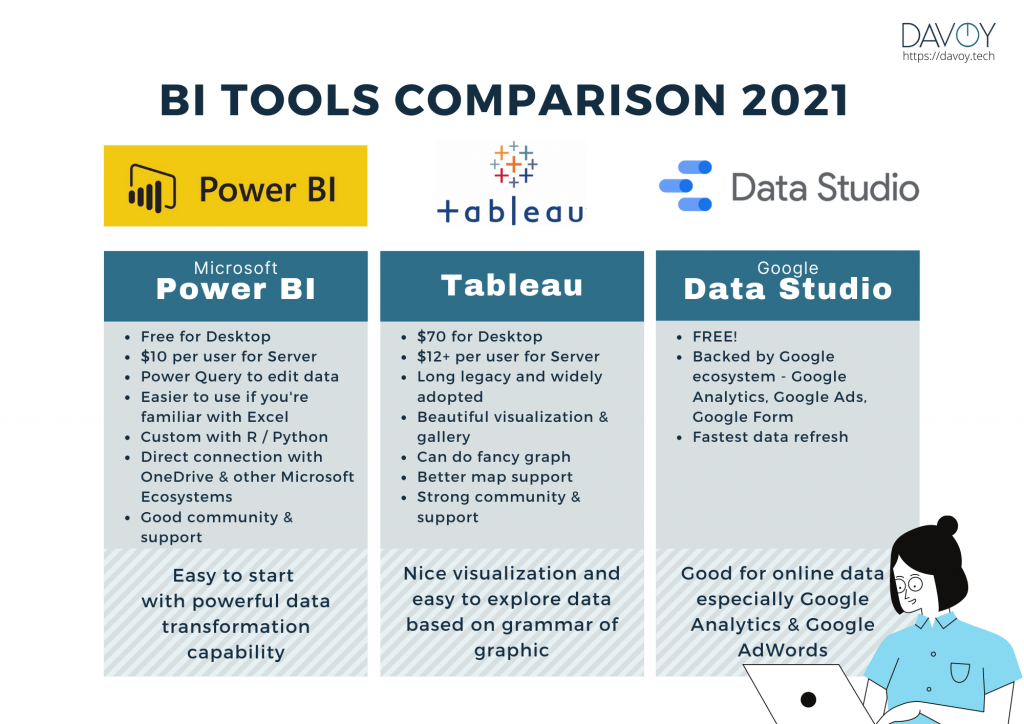

However, it certainly brings advanced dashboarding features such as drag-and-drop data through QlikSense - Qlik’s SaaS-based platform.
#Power bi desktop vs tableau install#
Connectors need to install separately by downloading from the Qlik website. Native connectors to enterprise applications, including Microsoft Office, Azure, Snowflake, SAP, and others.Broadly connects to both on-premises and cloud data sources.QlikView, a data discovery and analytics platform, provides data insights from a large volume of data sets. It includes native connectors for important enterprise platforms such as Microsoft Excel, MySQL, Google Analytics, Amazon Redshift, etc.It helps convert raw data into meaningful business insights and provides interactive dashboards.Tableau’s intuitive interface allows non-technical users to quickly and easily create dashboards that provide insight into a broad spectrum of enterprise information.Tableau is a data visualization tool that excels in helping organizations turn data into actionable insights through interactive dashboards and stories. Power BI is increasingly adopted by global organizations, including Fortune 500, enabling everyone to make data-driven decisions and drive data culture. For the last 13 consecutive years, Microsoft is holding the spot as a Leaders in Gartner’s Magic Quadrant Leader in analytics and business intelligence platforms. Power BI is positioned as a Leader in the 2021 Gartner Magic Quadrant for Analytics and Business Intelligence Platforms. Native integration with Microsoft technologies enables powerful data preparation and data querying capabilities.It is a robust enterprise-grade tool enabling extensive modeling and real-time analytics.Power BI helps you easily connect your data from different sources – Text files, streaming data, Microsoft Excel, on-premises data warehouses, or cloud-based data warehouses, etc.
#Power bi desktop vs tableau software#
It brings together apps, connectors, and software services to turn structured, semi structured, and unstructured data into visually immersive and interactive insights.The product was launched by Microsoft in 2011. Power BI is Microsoft’s analytics and data visualization tool that helps enterprises analyze and visualize massive volumes of data. Let us start to look the features and advantages of the afore-mentioned BI tools. Augmentation leverages machine learning and artificial intelligence for data preparation, insight generation and explanation to explore and analyze data more effectively. Differentiation has shifted to how well these platforms support augmented analytics. Data visualization capabilities no longer differentiate these BI tools.

Whether your organization is starting or in the middle of selecting the data visualization tools, I am sure you might have already heard about Power BI, Tableau and QlikView – top 3 popular BI tools. So how do you start and choose? Power BI vs. Selecting the right BI tool for your enterprise makes all the difference in deriving insights and make better business decisions. But the question is, how do you know which business intelligence and analytics tool are suitable for your enterprise? These tools ingest a large volume of structured and unstructured data from multiple sources, transform it, identify patterns, and help gain business insights.

How does an enterprise derive insights from such a massive volume of data?īusiness Intelligence and Analytics tools help enterprises understand trends and derive actionable insights from data to make strategic and tactical business decisions. Do data back your organization's business decisions? Enterprises that leverage data stay ahead of the competition by making better business decisions, increase the quality of products & services, and enhance customer experience. In fact, according to IDC, the world's data generated will grow from 29 Zettabytes in 2018 to 175 Zettabytes by 2022. More data was generated in the last two years than in the entire human history. The amount of data created have skyrocketed.


 0 kommentar(er)
0 kommentar(er)
